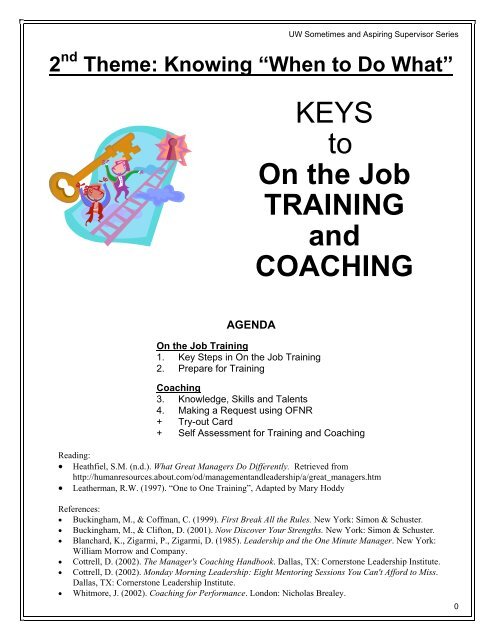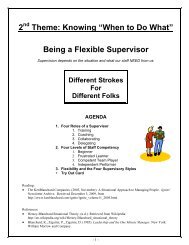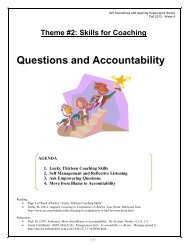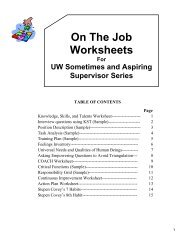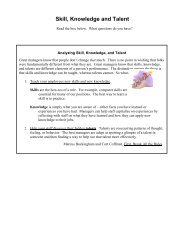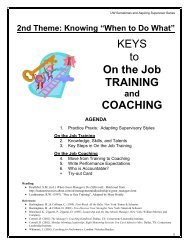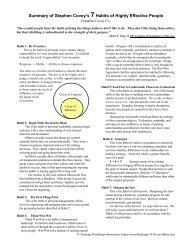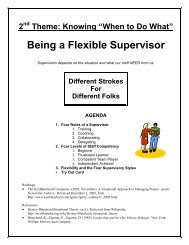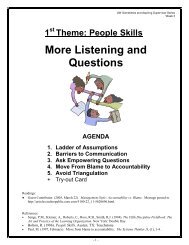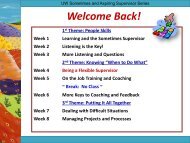KEYS to On the Job TRAINING and COACHING
KEYS to On the Job TRAINING and COACHING
KEYS to On the Job TRAINING and COACHING
Create successful ePaper yourself
Turn your PDF publications into a flip-book with our unique Google optimized e-Paper software.
UW Sometimes <strong>and</strong> Aspiring Supervisor Series2 nd Theme: Knowing “When <strong>to</strong> Do What”<strong>KEYS</strong><strong>to</strong><strong>On</strong> <strong>the</strong> <strong>Job</strong><strong>TRAINING</strong><strong>and</strong><strong>COACHING</strong>AGENDA<strong>On</strong> <strong>the</strong> <strong>Job</strong> Training1. Key Steps in <strong>On</strong> <strong>the</strong> <strong>Job</strong> Training2. Prepare for TrainingCoaching3. Knowledge, Skills <strong>and</strong> Talents4. Making a Request using OFNR+ Try-out Card+ Self Assessment for Training <strong>and</strong> CoachingReading:• Heathfiel, S.M. (n.d.). What Great Managers Do Differently. Retrieved fromhttp://humanresources.about.com/od/management<strong>and</strong>leadership/a/great_managers.htm• Lea<strong>the</strong>rman, R.W. (1997). “<strong>On</strong>e <strong>to</strong> <strong>On</strong>e Training”, Adapted by Mary HoddyReferences:• Buckingham, M., & Coffman, C. (1999). First Break All <strong>the</strong> Rules. New York: Simon & Schuster.• Buckingham, M., & Clif<strong>to</strong>n, D. (2001). Now Discover Your Strengths. New York: Simon & Schuster.• Blanchard, K., Zigarmi, P., Zigarmi, D. (1985). Leadership <strong>and</strong> <strong>the</strong> <strong>On</strong>e Minute Manager. New York:William Morrow <strong>and</strong> Company.• Cottrell, D. (2002). The Manager's Coaching H<strong>and</strong>book. Dallas, TX: Corners<strong>to</strong>ne Leadership Institute.• Cottrell, D. (2002). Monday Morning Leadership: Eight Men<strong>to</strong>ring Sessions You Can't Afford <strong>to</strong> Miss.Dallas, TX: Corners<strong>to</strong>ne Leadership Institute.• Whitmore, J. (2002). Coaching for Performance. London: Nicholas Brealey.0
UW Sometimes <strong>and</strong> Aspiring Supervisor Series<strong>On</strong> <strong>the</strong> <strong>Job</strong> Training1. Key Steps in <strong>On</strong> <strong>the</strong> <strong>Job</strong> TrainingReview <strong>the</strong> box below, with summarizes <strong>the</strong> article, “<strong>On</strong>e-<strong>to</strong>-one Training”.Steps in Effective <strong>On</strong> <strong>the</strong> <strong>Job</strong> Training1. Prepare for <strong>the</strong> training Update Position Description Write step-by-step analysis of task Write Training Plan2. Ask questions <strong>to</strong> determine trainee’s experience3. Tell <strong>the</strong> trainee about <strong>the</strong> task4. Show <strong>the</strong> trainee how <strong>the</strong> task is done5. Encourage <strong>the</strong> trainee <strong>to</strong> do <strong>the</strong> task6. Follow up <strong>to</strong> insure that <strong>the</strong> trainee can do <strong>the</strong> task2. Prepare for Training – The Most Common Missing StepPosition Description = Broad Overview of Tasks• Review sample Position Description, page 8 of <strong>Job</strong> Aids packetTask Analysis = Detail of HOW <strong>to</strong> do a taskYOURTURN• Review sample Task Analysis page 9 of <strong>Job</strong> Aids packet.• Write a Task Analysis for someone you supervise or for your own job on page 10.• Share your Task Analyses with your partner. Give each o<strong>the</strong>r feedback as abeginner on how well you underst<strong>and</strong> <strong>the</strong> directions <strong>and</strong> <strong>the</strong> language.Training Plan or Checklist = Document WHO is trained <strong>to</strong> do WHAT• Review <strong>the</strong> sample Training Checklist on page 12 of <strong>Job</strong> Aids packet.• At your table, describe what you’ve found makes on <strong>the</strong> job training successful orideas that you got from this week’s readings.ooo• We’ll share your strategies.1
UW Sometimes <strong>and</strong> Aspiring Supervisor Series3. Knowledge, Skills <strong>and</strong> TalentsRead <strong>the</strong> box below. What questions do you have?Great managers know that <strong>the</strong>re is no point in wishing that folks were fundamentally differentfrom what <strong>the</strong>y are. They know that skills, knowledge <strong>and</strong> talents are different elements of aperson’s performance. The distinction among <strong>the</strong> three is that skills <strong>and</strong> knowledge can betaught, whereas talents cannot. So what can managers do?1. Help staff learn new skills <strong>and</strong> new knowledge.Knowledge is simply what you are aware of – ei<strong>the</strong>r facts you have learned orexperiences you have had. Managers can help staff capitalize on experiences byreflecting with staff on what <strong>the</strong>y have learned <strong>and</strong> how <strong>the</strong>y can apply newknowledge <strong>to</strong> <strong>the</strong>ir jobs.Skills are <strong>the</strong> actions or what we DO with knowledge. For example, computer skillsare essential for many of our positions. The best way <strong>to</strong> learn a skill is <strong>to</strong>practice.2. Help staff discover <strong>the</strong>ir hidden talents. Buckingham describes talents arereoccurring patterns of thought, feeling, or behavior. You can also think of <strong>the</strong>m asnatural gifts. The best managers are adept at spotting a glimpse of a talent insomeone <strong>and</strong> <strong>the</strong>n finding a way <strong>to</strong> develop it.Adapted by Mary Hoddy from Marcus Buckingham <strong>and</strong> Curt Coffman, First, Break All <strong>the</strong> RulesWrite some of your Knowledge, Skills, <strong>and</strong> Talents on <strong>the</strong> chart below.Example: A cashier needs <strong>to</strong>…Knowledge Skills TalentsKnow correct procedures & rules Strike correct keys without looking Have precision under stressShare your Knowledge, Skills <strong>and</strong> Talents with a partner. Can you add <strong>to</strong> your partner’s chart?2
UW Sometimes <strong>and</strong> Aspiring Supervisor Series3. Knowledge, Skills <strong>and</strong> Talents continuedApplying Knowledge, Skills <strong>and</strong> Talents <strong>to</strong> InterviewingTurn <strong>to</strong> <strong>Job</strong> Aids page 9 <strong>and</strong> review Interview Questions using Knowledge, Skills <strong>and</strong>Talents.Behavioral Interviewing: The best predic<strong>to</strong>r of future behavior is past behaviorStep <strong>On</strong>e: Decide what Knowledge, Skills <strong>and</strong> talents you are looking for.Examples for <strong>the</strong> facilita<strong>to</strong>r’s position:Knowledge: Underst<strong>and</strong>ing of principles of adult educationSkill: Presentation skillsTalent: Taking initiative, working independently, creativityStep Two: Write a question that asks <strong>the</strong> interviewee <strong>to</strong> describe <strong>the</strong>irunderst<strong>and</strong>ing of knowledge, or a time when <strong>the</strong>y demonstrated a skill or talent.Examples:• Knowledge: Describe three principles of adult education that you believe are <strong>the</strong>most important <strong>and</strong> give examples of how you apply <strong>the</strong>m in <strong>the</strong> classroom.• Skill: At <strong>the</strong> end of this interview, you will present a 20 minute presentation on a <strong>to</strong>picof your choice. Please bring your facilita<strong>to</strong>r plan which includes <strong>the</strong> objectives <strong>and</strong>outline of <strong>the</strong> presentation. If you would like AV, please let us know 48 hours inadvance.• Talent: Describe a time when you had <strong>to</strong> taking initiative <strong>to</strong> get a project completed.What challenges did you have <strong>and</strong> how did you resolve <strong>the</strong>m?YOURTURNIndividually, write three behavioral interview questions for a position you need <strong>to</strong>interview for, or for your own position.• Knowledge:• Skill:• Talent:3
4. Making a Request Using OFNR continuedUW Sometimes <strong>and</strong> Aspiring Supervisor SeriesSteps for Giving Feedback1. Make an observation“I noticed that you came in 10 minutes late <strong>to</strong>day.”• Clearly state what you see• Be specific as per time <strong>and</strong> context• Eliminate evaluations <strong>and</strong> judgmentsPause. Give chance <strong>to</strong> hear what happened. Offer empa<strong>the</strong>tic listening <strong>to</strong> make sure you underst<strong>and</strong>.2. Describe how you felt• Take responsibility for your feelings“I was frustrated….3. Your needs / or what happed becauseof <strong>the</strong> behavior (<strong>the</strong> consequences)“because I covered <strong>the</strong> front desk until you came <strong>and</strong> Ineed <strong>to</strong> be efficient in getting my work done”Are you choosing <strong>to</strong> connect or disconnect? (internal dialogue) Might say…….“because I covered <strong>the</strong> front desk until you arrived. Idepend on you <strong>to</strong> serve our cus<strong>to</strong>mers during our openoffice hours.”Pause again. Offer empa<strong>the</strong>tic listening again if appropriate.4. Check for clarity “What do you underst<strong>and</strong> I’m saying?”“What do you underst<strong>and</strong> our procedure is……..?”5. Make a request.• People always have a choice• Ensure that consequences of <strong>the</strong>irchoices are clearYOURTURN“Would you be willing <strong>to</strong> come at ___from now on?”“Would you be willing <strong>to</strong> call me if something comes up<strong>and</strong> you’ll be more than 5 minutes late?”Drafting Feedback for Someone I Work With1. Make an observation “I noticedPause. Give chance <strong>to</strong> hear what happened. Offer empa<strong>the</strong>tic listening <strong>to</strong> make sure you underst<strong>and</strong>.2. Describe how you felt “I was3. Your needs / or what happed because of<strong>the</strong> behavior (<strong>the</strong> consequences)“becausePause again. Offer empa<strong>the</strong>tic listening again if appropriate.4. Check for clarity “What do you underst<strong>and</strong> I’m saying?”5. Make a request. “Would you be willing“Are you able <strong>to</strong>In <strong>the</strong> same pairs,Take turns offering your feedback <strong>to</strong> each o<strong>the</strong>r:React as if you were really in this situation.5


